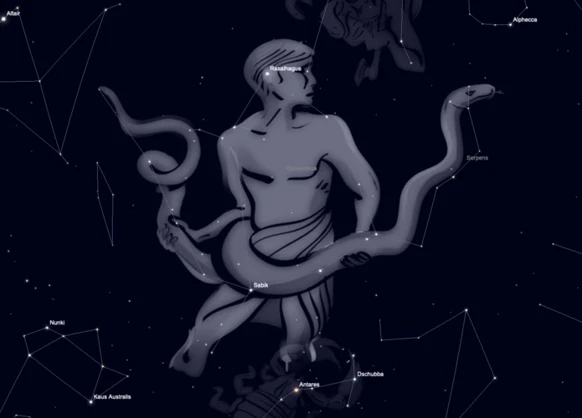The Ophiuchus constellation has long been shrouded in mystery and captivated stargazers around the world. Its enigmatic origins and celestial significance make it a fascinating subject of exploration. Delving into the rich mythology, symbolism, and astrological controversies surrounding Ophiuchus, we uncover a hidden world of ancient legends and cosmic connections. This article takes you on a journey to unravel the secrets of Ophiuchus, from its Greek mythological roots to its disputed position in astrology. We also delve into the major stars and constellation features, as well as provide guidance on how to locate and observe Ophiuchus in the night sky. Join us as we untangle misunderstandings and misconceptions about this intriguing constellation and discover the truth behind the Ophiuchus myth.
The Legend of Ophiuchus
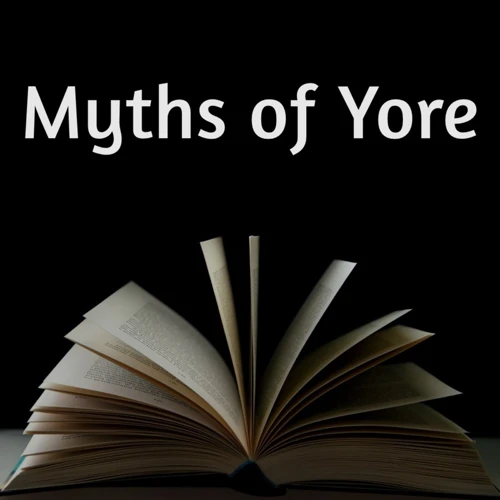
According to ancient legend, Ophiuchus is associated with the Greek myth of Asclepius, the legendary healer and son of Apollo. Asclepius was known for his incredible ability to resurrect the dead, which ultimately drew the attention of the gods. In one version of the myth, Zeus, fearing that Asclepius’ powers would disrupt the natural order and upset the balance between life and death, struck him down with a thunderbolt. However, out of respect for his healing skills, Zeus immortalized Asclepius by placing him among the stars as the constellation Ophiuchus, the Serpent Bearer. The symbolism of the serpent in the constellation represents Asclepius’ ability to heal, as snakes were believed to possess regenerative powers. This connection between Ophiuchus and healing is further emphasized in astrology, where the constellation is associated with rejuvenation and transformative energy. The legend of Ophiuchus serves as a reminder of the timeless pursuit of knowledge and the power of healing throughout human history. (Source: source)
The Symbolism of the Serpent Bearer
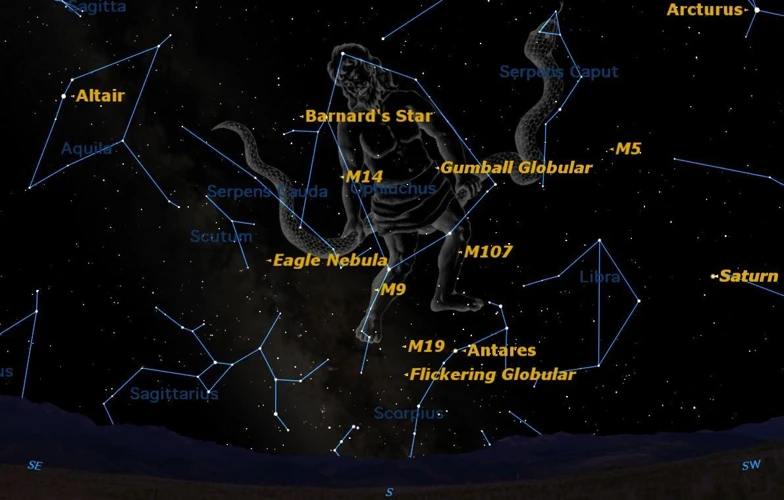
The symbolism of the Serpent Bearer in the Ophiuchus constellation holds deep meaning and significance across various cultures and belief systems. In Greek mythology, the serpent represents wisdom, enlightenment, and healing. The image of the serpent wrapped around the staff or rod, known as the Rod of Asclepius, has become a universally recognized symbol of medicine and healthcare. Here, the serpent embodies the transformative power of healing and the restoration of balance. In astrology, Ophiuchus is associated with traits such as intuition, wisdom, and a desire for spiritual growth. Some even argue that Ophiuchus should be recognized as the 13th zodiac sign, challenging the traditional zodiac system. The symbolism of the Serpent Bearer thus encompasses themes of regeneration, knowledge, and the pursuit of enlightenment. (Source: source)
1. Ophiuchus in Greek Mythology
In Greek mythology, Ophiuchus is strongly associated with the legend of Asclepius, the divine physician. As the son of the Greek god Apollo, Asclepius possessed exceptional healing abilities. His reputation as a master healer grew so immense that he could even resurrect the dead, a feat that alarmed the gods. Zeus, the king of the gods, struck Asclepius down with a thunderbolt in response to the disruption of the natural order. However, recognizing his invaluable contributions to medicine, Zeus immortalized Asclepius by placing him in the night sky as the constellation Ophiuchus. The constellation depicts a man holding a serpent, symbolizing Asclepius’ expertise in healing and the close association between medicine and snakes in ancient Greek culture. Since then, Ophiuchus has remained a prominent figure in Greek mythology, representing the power and wisdom of healing. The constellation serves as a reminder of the enduring legacy of Asclepius and the important role medicine and healing play in our lives. (Source: source)
2. Ophiuchus in Other Cultures
In addition to its significance in Greek mythology, Ophiuchus also holds cultural significance in other civilizations across the world. In Egyptian mythology, Ophiuchus is closely associated with the god Imhotep, who was not only a healer but also revered as the founder of medicine. Imhotep was often depicted holding a staff with a serpent wrapped around it, symbolizing healing and wisdom, much like the symbolism associated with Ophiuchus in Greek mythology. Similarly, in Mayan culture, Ophiuchus is connected to the deity known as Aesculapius or the Vision Serpent, who was revered as a healer and guardian of knowledge. The serpent imagery in these cultures also represents wisdom and transformation, reflecting the universal symbolism attributed to Ophiuchus. Across different civilizations, Ophiuchus emerges as a figure embodying healing abilities, knowledge, and spiritual transformation. It is fascinating to observe how various cultures around the world have incorporated the constellation into their mythologies, highlighting the enduring universal appeal of Ophiuchus.
The Alignment with Astrology
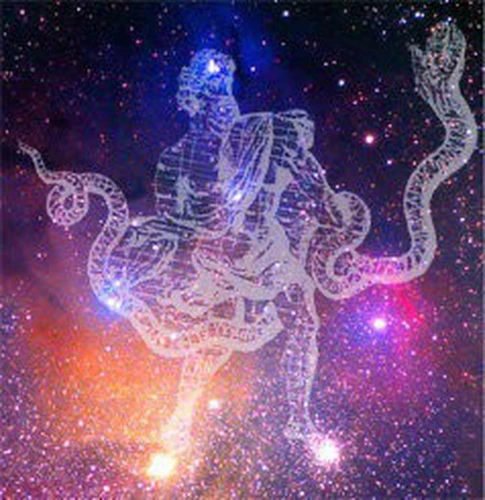
The alignment of Ophiuchus with astrology has been a topic of debate and controversy in modern times. While the traditional zodiac consists of 12 signs, Ophiuchus lies between Scorpio and Sagittarius, leading some to question its role in astrological interpretations. This has sparked discussions about the inclusion of Ophiuchus as a thirteenth zodiac sign. However, it’s important to note that mainstream astrology still adheres to the traditional zodiac system, excluding Ophiuchus from its predictions and personality traits. On the other hand, some astrologers argue that Ophiuchus should be acknowledged and integrated into astrological interpretations, emphasizing its association with healing, transformation, and spiritual growth. Regardless of its status in astrology, Ophiuchus remains a captivating constellation with its own symbolism and mythology. Exploring the alignment of Ophiuchus with astrology provides a fascinating glimpse into the evolving interpretations of celestial patterns and their impact on our understanding of human nature. (Source: source)
1. The Ophiuchus Zodiac Controversy
The Ophiuchus Zodiac controversy stems from the disagreement over whether or not Ophiuchus should be included as an official zodiac sign. In astrology, the zodiac is divided into twelve signs, each associated with specific dates and personality traits. However, some argue that the inclusion of Ophiuchus as a thirteenth sign would disrupt the established system. Ophiuchus aligns with the dates November 29 to December 17, overlapping with the neighboring sign of Sagittarius. Proponents of the thirteenth sign claim that Ophiuchus represents a transformational and spiritually inclined individual, adding depth and complexity to astrological interpretations. Detractors argue that adding Ophiuchus would require a total realignment of the zodiac system and confuse those who identify strongly with their birth sign. The controversy surrounding Ophiuchus and its potential impact on astrology continues to spark debates among enthusiasts and astrologers alike. (Source: Ophiuchus and the Zodiac Signs)
2. Personality Traits of Ophiuchus
The personality traits of Ophiuchus individuals are believed to be shaped by the celestial energy and symbolism associated with this unique zodiac sign. Ophiuchus is often described as having a magnetic and charismatic personality, drawing others towards them with their natural charm and confidence. They possess a strong sense of justice and are driven to fight for what they believe in. Ophiuchus individuals are known for their healing abilities, both in a physical and emotional sense. They have a deep compassion for others and strive to bring about positive change in the world. Ophiuchus individuals are highly intuitive and possess great wisdom. They are natural leaders and have the ability to inspire and motivate those around them. However, they can also be prone to moments of intense emotions and may struggle with finding balance in their lives. Ophiuchus individuals are constantly seeking knowledge and are eager to explore new experiences and ideas. They are adventurous, open-minded, and unafraid to take risks. The personality traits of Ophiuchus individuals reflect their connection to healing, transformation, and growth. (Source: source)
The Major Stars and Constellation Features
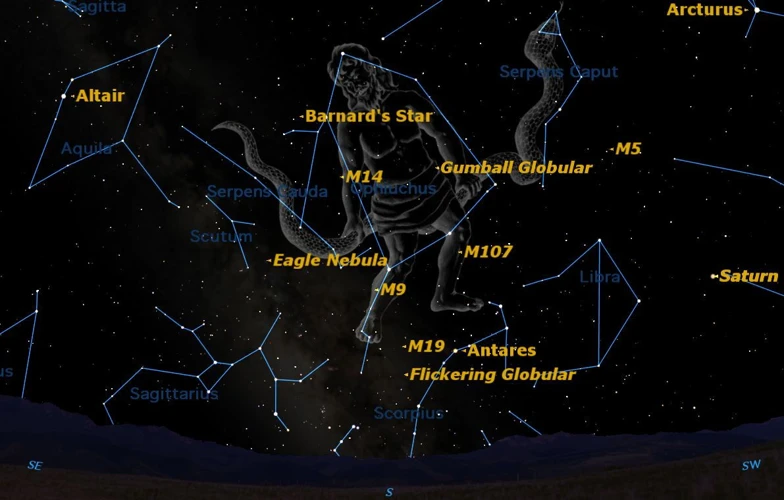
The Ophiuchus constellation boasts several notable stars and captivating features that add to its mystical allure. One of the key stars in Ophiuchus is Rasalhague, a vibrant blue-white giant located at the head of the Serpent Bearer. With its luminosity and prominent position, Rasalhague is a prominent guide for stargazers looking to identify the constellation. Another significant star in Ophiuchus is Sargas, a bright yellow supergiant that adds to the constellation’s brilliance. Additionally, the dark nebula known as the Barnard 68 can be found within the boundaries of Ophiuchus, appearing as a cloud-like formation against the backdrop of stars. This unique feature adds depth and intrigue to the constellation when observed through telescopes. As stargazers explore the celestial wonders of Ophiuchus, these major stars and constellation features serve as celestial landmarks, offering a captivating visual experience. (Source: source)
1. Key Stars in Ophiuchus
1. Key Stars in Ophiuchus:
Ophiuchus is home to several notable stars that contribute to the constellation’s celestial beauty. One of the most prominent stars in Ophiuchus is Rasalhague (Alpha Ophiuchi), a binary star system located at the head of the serpent bearer. Known for its bluish-white appearance, Rasalhague shines with a magnitude of 2.07, making it one of the brightest stars in the constellation.
Another significant star in Ophiuchus is Cebalrai (Beta Ophiuchi), situated at the serpent bearer’s right shoulder. Cebalrai has a yellow-white hue and has an apparent magnitude of 2.76. It is easily identifiable and adds to the overall splendor of the constellation.
Alphecca (Alpha Coronae Borealis), also known as Gemma, is another star that is often associated with Ophiuchus. Although officially part of the neighboring constellation Corona Borealis, Alphecca lies close to Ophiuchus and is sometimes included in its depiction. Alphecca is a binary star system and serves as a guidepost that helps locate Ophiuchus in the night sky.
Lastly, let us not forget Kappa Serpentis (Unukalhai), a red giant star located in the serpent’s coils. Unukalhai has a magnitude of 2.63 and adds an element of radiance to the constellation.
These key stars in Ophiuchus contribute to its visual allure and make it a captivating sight for stargazers and astronomers alike. Their distinct characteristics and positions within the constellation create a celestial tapestry that fascinates and inspires us to explore the wonders of the night sky.
2. Notable Celestial Objects
When exploring the Ophiuchus constellation, there are several notable celestial objects that grace the night sky within its boundaries. One such object is the Rasalhague, also known as Alpha Ophiuchi. This bright star is situated at the head of the Serpent Bearer and serves as one of the main reference points for locating the constellation. With a magnitude of 2.07, Rasalhague is easily visible to the naked eye. Another prominent star in Ophiuchus is Sabik, also known as Eta Ophiuchi. It is a binary star system consisting of two stars that orbit each other. Sabik is an incredibly luminous star, with a magnitude of 2.43. Moving beyond stars, Ophiuchus is also home to several noteworthy deep-sky objects. The Barnard’s Star, a red dwarf star located near the celestial equator, can be found in Ophiuchus. The Ophiuchus Galaxy Cluster is a rich gathering of galaxies residing behind the constellation, making it a captivating area of study for astronomers. These celestial objects within Ophiuchus add to its allure and offer astronomers and stargazers a vast cosmic canvas to explore.
Exploring Ophiuchus in the Night Sky
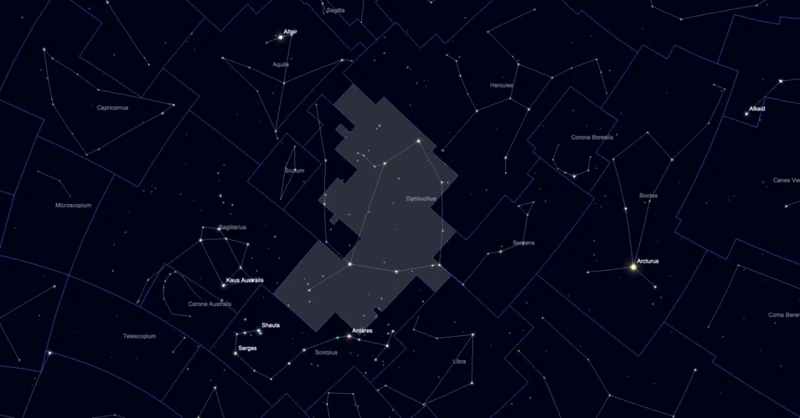
Exploring Ophiuchus in the night sky can be a thrilling experience for astronomy enthusiasts. To locate the constellation, start by finding the bright orange star Antares in the neighboring constellation Scorpius, as Ophiuchus lies just above it. One way to identify Ophiuchus is by looking for its distinct curved shape, resembling a person holding a serpent. Another significant feature is the red supergiant star, Rasalhague, which marks the head of the Serpent Bearer. If you have a telescope, you can also observe some fascinating celestial objects in Ophiuchus. The globular cluster M12, also known as the Gumball Cluster, is a stunning sight with its densely packed stars. Another notable object is the dark nebula Barnard 68, which appears as a cloud obscuring the stars behind it. So, grab your telescope or binoculars and embark on an exploration of Ophiuchus, unraveling its celestial wonders in the vast night sky.
1. Finding Ophiuchus in the Sky
Finding Ophiuchus in the night sky can be a thrilling adventure for stargazers. Since Ophiuchus lies along the celestial equator, it is visible from both the Northern and Southern Hemispheres. To locate the constellation, one can begin by identifying the familiar constellation of Orion. By looking towards the east, Orion’s belt can be used as a guide to trace a line towards the south. Traveling along this line, stargazers will come across the bright, reddish star called Antares, which belongs to the neighboring constellation of Scorpius. From Antares, continue to scan upward, and you will spot the distinct shape of Ophiuchus. It is characterized by a winding serpent, represented by the stars that form the constellation’s body. The head of the serpent is marked by the star Rasalhague, while the stars Lambda, Chi, and Tau make up the base of the serpent. This celestial configuration makes Ophiuchus an easily recognizable and fascinating sight in the night sky. So, grab a star chart, find your way to a dark location free from light pollution, and prepare to embark on an awe-inspiring journey to witness the celestial wonders of Ophiuchus.
2. Observing Ophiuchus Constellation
Observing the Ophiuchus constellation can be an enthralling experience for astronomy enthusiasts. To locate Ophiuchus in the night sky, start by looking towards the southern sky during the summer months in the Northern Hemisphere or the winter months in the Southern Hemisphere. Ophiuchus is positioned between the constellations of Scorpius and Sagittarius. Look for the distinctive shape of a man holding a serpent in his hands, depicted by the stars within the constellation. The brightest star in Ophiuchus is Rasalhague, which serves as the head of the Serpent Bearer. A useful guide for stargazers is to use nearby bright stars, like Antares in Scorpius and Vega in Lyra, to trace a path to Ophiuchus. Since Ophiuchus is a large constellation, it may be easier to identify individual stars and celestial objects within its boundaries using a star chart or a smartphone app. Once found, take the time to observe the celestial wonders within Ophiuchus, such as globular clusters and nebulae that reside within its borders. Whether through binoculars or a telescope, exploring the details of the Ophiuchus constellation can offer a mesmerizing journey into the depths of the cosmos.
Misunderstandings and Misconceptions
Misunderstandings and misconceptions surround the Ophiuchus constellation, leading to confusion and misinterpretation. One common misconception is the belief that Ophiuchus is a new zodiac sign, disrupting the traditional twelve sign system. However, it’s important to clarify that Ophiuchus is not officially recognized as a zodiac sign in mainstream astrology. Another misconception relates to the personality traits associated with Ophiuchus. Some people mistakenly assume that Ophiuchus individuals possess specific characteristics and traits. However, it’s essential to remember that astrology is complex and multifaceted, and no single constellation can define an entire person’s personality or behavior. Gaining a deeper understanding of Ophiuchus requires separating fact from fiction and appreciating the rich symbolism and mythology that surrounds this captivating constellation.
1. Ophiuchus and the Zodiac Signs
The inclusion of Ophiuchus in the zodiac signs is a topic of much debate and controversy. Traditionally, the zodiac consists of twelve signs, each representing specific personality traits and characteristics. However, Ophiuchus is not officially recognized as one of these signs. Some argue that Ophiuchus should be acknowledged as the thirteenth zodiac sign, as its position in the sky aligns with the sun at a certain time of the year. This has led to speculations about the shifting of astrological dates and the impact it may have on individual horoscopes. Ophiuchus is believed to exhibit traits such as determination, passion, and an affinity for seeking knowledge. Its association with healing and wisdom further adds to its astrological significance. While astrologers may interpret Ophiuchus differently, it’s important to note that the inclusion of this serpent bearer in the zodiac remains a subject of ongoing discussion and interpretation. (Source: source)
2. The Ophiuchus Personality Stereotypes
The inclusion of Ophiuchus as a potential zodiac sign has sparked various personality stereotypes and characteristics associated with individuals born under this constellation. However, it’s important to note that these stereotypes are subjective and not scientifically proven. Some belief systems suggest that Ophiuchus individuals possess exceptional healing abilities, a magnetic presence, and a deep connection with spiritual and occult practices. These stereotypes often portray Ophiuchus as mysterious, intuitive, and wise beyond their years. Others view Ophiuchus as rebellious and prone to questioning authority, representing an alternative perspective within the zodiac system. However, it is crucial to approach these stereotypes with caution, as assigning specific traits to individuals based solely on their zodiac sign can be reductive and overlook the complexity of human personalities. It’s essential to recognize that each person is unique and influenced by a multitude of factors beyond their zodiac sign. (Source: source)
Conclusion
In conclusion, the mythology behind the Ophiuchus constellation is steeped in ancient tales of healing and transformation. Its association with the Greek myth of Asclepius, the renowned healer, adds depth and significance to its symbolism as the Serpent Bearer. Throughout history, humans have looked to the stars for guidance, seeking answers and solace in the vastness of the cosmos. While modern astrology may debate the inclusion of Ophiuchus as a zodiac sign, the constellation’s influence cannot be denied. Its stars and celestial objects continue to captivate astronomers and stargazers alike. Whether you view Ophiuchus as a part of the zodiac or as a celestial marvel, exploring its mythology and appreciating its beauty in the night sky can deepen our understanding and appreciation of our place in the universe. So next time you gaze up at the stars, take a moment to locate Ophiuchus and ponder the rich history and enduring mystery it represents. (Source: source)
Frequently Asked Questions
1. What does Ophiuchus represent in Greek mythology?
In Greek mythology, Ophiuchus represents Asclepius, the legendary healer and son of Apollo. He was known for his ability to resurrect the dead, which ultimately led to his immortalization as the constellation Ophiuchus.
2. Is Ophiuchus considered a part of the zodiac signs?
While Ophiuchus is not officially recognized as one of the traditional zodiac signs, there is ongoing debate and controversy surrounding its inclusion in the zodiac. Some astrologers believe it should be considered the thirteenth sign, while others disagree.
3. How can I locate Ophiuchus in the night sky?
Ophiuchus can be found in the southern celestial hemisphere, between the constellations of Scorpius and Sagittarius. Look for a pattern of stars resembling a man holding a snake, which represents Ophiuchus, the Serpent Bearer.
4. What are the major stars in the Ophiuchus constellation?
Some of the key stars in the Ophiuchus constellation include Rasalhague (Alpha Ophiuchi), Sabik (Eta Ophiuchi), and Cebalrai (Beta Ophiuchi). These stars contribute to the unique shape and character of Ophiuchus in the night sky.
5. What are the personality traits associated with Ophiuchus?
Due to its disputed status as a zodiac sign, there are no universally agreed-upon personality traits for Ophiuchus. However, some astrologers describe individuals born under Ophiuchus as being intuitive, creative, and possessing a strong desire for knowledge and healing.
6. Can Ophiuchus be observed throughout the year?
Yes, Ophiuchus can be observed from different parts of the world throughout the year. However, its visibility may vary depending on the observer’s latitude and the current season.
7. What are the notable celestial objects within the Ophiuchus constellation?
The Ophiuchus constellation is home to several notable celestial objects, including the Barnard’s Star, a red dwarf that is one of the closest stars to our Solar System, and the globular cluster Messier 10, which contains hundreds of thousands of stars.
8. Is there a connection between Ophiuchus and astrology in modern times?
Ophiuchus has sparked controversy and discussion within the astrological community regarding its significance in modern astrology. Some astrologers argue for its inclusion as a zodiac sign, while others maintain the traditional twelve sign system.
9. What are some misunderstandings about Ophiuchus and the zodiac signs?
One common misunderstanding is that everyone’s zodiac sign would automatically change if Ophiuchus were to be officially recognized. In reality, the determination of one’s zodiac sign is based on the position of the Sun at the time of birth, not the existence of Ophiuchus.
10. Are there any stereotypes associated with the Ophiuchus personality?
As Ophiuchus is not universally recognized as a zodiac sign, there are fewer stereotypes associated with it compared to the twelve traditional zodiac signs. However, some individuals may hold preconceived notions about Ophiuchus personalities based on various astrology interpretations.

